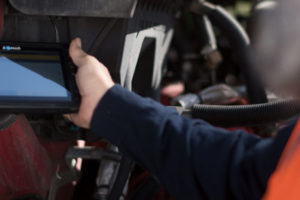A fleet manager recently told us, “If idle hands make fretful minds, then idle time kills bottom lines.” Fuel costs, comprising roughly 60% of most fleet budgets, make idling a financial Achilles heel. Idling is, in certain respects, the silent killer of bottom lines. It’s like the leaky pipe under garden, slowly and quietly dripping pennies that add up to thousands of dollars per vehicle per year.
While that leaky pipe can be repaired and costs shut off entirely, the best a fleet manager can do is reduce idle time but not eliminate it completely.
Aggressively reducing that idle time is where the value of telematics lies. In this article, we’ll provide reminders about the most common idle time culprits, estimate the cost of idling, and then show how telematics can reduce idle time considerably.
Definitions
We’ll define “idle time” as “the period when a vehicle is operating but stationary.” The most common instances of idle time are:
Stop signs
Traffic lights
Toll booths
Traffic congestion
Loading and unloading operations
Document preparation and processing
Engine and cab warm-up before departure
Phone use stops
Rest stops
Costs
The costs are significant and have increased along with the price of diesel fuel. According to the U.S. Department of Agriculture, the average price per gallon of diesel rose from $2.37 in 2016 to $4.38 in July of 2023, an 85% increase.
The U.S. Office of Energy Efficiency and Renewable Energy (EERE) reports that 34% of vehicles idle for less than one hour per day, 39% idle for three to four hours, and 14% idle for more than four hours per day. Every 10% of idle time can result in a 1% decline in fuel efficiency. In sum, this idle time costs an estimated $22,000 per fleet truck annually. With some 11.4 million trucks on the roads, the value of lost fuel exceeds $125 billion annually.
This does not include indirect and additional costs from excessive idling, which includes higher maintenance costs, environmental damages, and health hazards. The Environmental Protection Agency (EPA) posits that idling increases annual maintenance costs by around $2,000 per truck and contributes to 28% of all U.S. greenhouse gas emissions. Moreover, University of Michigan studies have shown a correlation between vehicle fumes, idling, and increased incidences of cancer, asthma, and birth defects.
This brings us to telematics—the keystone to managing and reducing idle time. Advanced GPS fleet management and telematics software offer several features aimed at mitigating idle time.
Driver Behavior Reports
These reports track driver actions, including idling, speeding, braking, aggressive driving, and cornering, which can affect vehicle performance, fuel consumption, and durability. By identifying drivers who idle excessively, customized training and coaching can rectify these habits.
To that end, please consider our suggestions on effective driver coaching.
One tactic to consider in coaching sessions is to simply educate the driver regarding the cost of idling. Newer, younger drivers may be particularly unaware about how idle costs add up. Showing them actual idle time, cost per minute in diesel fuel, and total cost per year is a straightforward and direct method of education that will likely yield results.
Idle Time Tracking
Telematics software can simultaneously monitor engine diagnostics and idle time. When a vehicle idles beyond a defined limit, it can alert the driver and the manager, encouraging the driver to turn off the engine and enabling you to identify and manage drivers who idle excessively. Some telematics providers have an “idle shutdown” feature that can auto-stop engines after a set idle time.
With Zonar Ground Traffic Control, idle time reports are extensive and offer many features and insights. Have a look here.
GPS Idle Time Reports
Electronic logging devices can track idling duration and location. This information helps determine idling causes and devise solutions such as auxiliary unit installation or new idling rules, the adherence to which can be monitored with the same software.
Idle locations can be another useful tool when it comes to optimizing delivery routes. Cross-referencing telematics information provided on idle location and traffic congestion may highlight the need to change routing based on time of day traveled in metropolitan congestion zones.
Geofencing
Geofencing establishes a virtual perimeter around geographic areas associated with high idling. An alert is sent when a vehicle enters a geofenced area, enabling timely interventions. Cross-referencing geofenced areas with routing software may allow a driver to alter his route on the fly so as to optimizing routing in real-time.
To conclude, tackling idle time is more than just a cost-saving strategy—it can demonstrate a testament to a fleet’s commitment to sustainable business practices. As environmental consciousness becomes increasing important in how companies select trucking fleets, the strategic deployment of telematics for monitoring and reducing idle time can have a halo effect on your business.
In the battle against idle time, telematics is your most potent ally. Lean on it and watch your fleet become the epitome of efficiency and sustainability.







